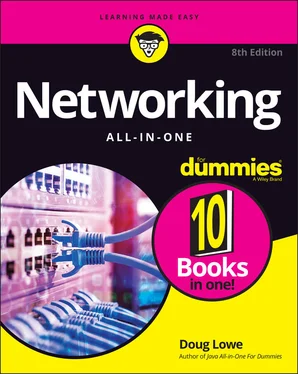8 Book 4: Implementing a Network Chapter 1: Network Hardware Working with Cable Installing Switches Chapter 2: Wireless Networks Installing a Wireless Access Point Configuring a Wireless Access Point Connecting to a Wireless Network Paying Attention to Wireless Network Security Chapter 3: Windows Clients Configuring Network Connections Joining a Domain Chapter 4: Mac Networking Basic Mac Network Settings Joining a Domain Connecting to a Share Chapter 5: Network Printers Configuring Network Printers Chapter 6: Virtual Private Networks Understanding VPN Looking at VPN Security Understanding VPN Servers and Clients
9 Book 5: Implementing Virtualization Chapter 1: Hyper-V Understanding the Hyper-V Hypervisor Understanding Hyper-V Virtual Disks Enabling Hyper-V Getting Familiar with Hyper-V Creating a Virtual Switch Creating a Virtual Disk Creating a Virtual Machine Installing an Operating System Chapter 2: VMware Looking at vSphere Getting Started with VMware Workstation Pro Creating a Virtual Machine Installing VMware Tools Chapter 3: Azure Looking at Azure Services Creating an Azure Account Examining the Azure Portal Creating a Windows Virtual Machine Managing an Azure Virtual Machine Connecting to an Azure Virtual Machine Chapter 4: Amazon Web Services Looking at What Amazon Web Services Can Do Creating an Amazon Web Services Account Examining the Amazon Web Services Console Creating a Windows Virtual Machine Managing an Amazon Web Services Virtual Machine Connecting to an Amazon Web Services Virtual Machine Chapter 5: Desktop Virtualization Introducing Desktop Virtualization Considering Two Approaches to Desktop Virtualization Looking at VMware’s Horizon View Looking at Citrix XenApp
10 Book 6: Implementing Windows Server 2019 Chapter 1: Installing Windows Server 2019 Planning a Windows Server Installation Before You Install … Running Setup Considering Your Next Steps Adding Server Roles and Features Chapter 2: Configuring Windows Server 2019 Using the Administrator Account Using Remote Desktop Connection Using Microsoft Management Console Customizing MMC Chapter 3: Configuring Active Directory What Directories Do Remembering the Good Ol’ Days of NT Domains Active Directory to the Rescue Understanding How Active Directory Is Structured Creating a New Domain Creating an Organizational Unit Chapter 4: Configuring User Accounts Understanding Windows User Accounts Creating a New User Setting User Properties Resetting User Passwords Disabling and Enabling User Accounts Deleting a User Working with Groups Working with User Profiles Creating a Logon Script Chapter 5: Configuring a File Server Understanding Permissions Understanding Shares Considering Best Practices for Setting Up Shares Managing Your File Server Chapter 6: Using Group Policy Understanding Group Policy Enabling Group Policy Management on Windows Server 2019 Creating Group Policy Objects Filtering Group Policy Objects Chapter 7: Typing Windows Commands Using a Command Window Special Command Tricks The EventCreate Command Net Commands The RunAs Command Chapter 8: Using PowerShell Using PowerShell Understanding PowerShell Commands Using Cmdlets Using Parameters Getting Help Using Aliases Using the Pipeline Using Providers Using Scripts
11 Book 7: Administering Microsoft Office 365 Chapter 1: Getting Started with Office 365 Administration Introducing Office 365 Considering Office 365 Plans Understanding Tenants Creating an Office 365 Tenant Creating a New User Resetting a User’s Password Disabling a User Chapter 2: Configuring Exchange Online Looking at Exchange Online Recipient Types Examining the Exchange Admin Center Managing Mailboxes Creating a Shared Mailbox Chapter 3: Administering Teams What Is Teams? A Brief Look at How Teams Works Using the Teams Admin Center Managing Teams
12 Book 8: Implementing Linux Chapter 1: Installing a Linux Server Planning a Linux Server Installation Installing Fedora Server Chapter 2: Linux Administration On Again, Off Again Wait, Where’s the Desktop? Playing the Shell Game Getting into Virtual Consoles Using a Remote Console Enabling the root User Using the sudo Command Using the RPM Package Manager Editing Text Files with Vi Using Cockpit Managing User Accounts Chapter 3: Basic Linux Network Configuration Using Cockpit to Configure Network Interfaces Working with Network Configuration Files Displaying Your Network Configuration with the ifconfig Command Chapter 4: Running DHCP and DNS Running a DHCP Server Running a DNS Server Chapter 5: Doing the Samba Dance Understanding Samba Installing Samba Starting and Stopping Samba Editing the smb.conf File Using the Samba Client Chapter 6: Running Apache Installing Apache Starting and Stopping Apache Opening the Firewall for Apache Confirming That Apache Is Running Looking at the httpd.config File Understanding Access Rules Configuring Virtual Hosts Chapter 7: Running Postfix Understanding Email Installing Postfix Modifying main.cf Using SpamAssassin Using the Mail Console Client Chapter 8: Linux Commands Command Shell Basics Directory- and File-Handling Commands Commands for Working with Packages and Services Commands for Administering Users Commands for Managing Ownership and Permissions Networking Commands
13 Book 9: Managing a Network Chapter 1: Welcome to Network Administration Knowing What Network Administrators Do Choosing the Part-Time Administrator Establishing Routine Chores Managing Network Users Patching Up Your Operating System and Software Discovering Software Tools for Network Administrators Building a Library Getting Certified Gurus Need Gurus, Too Helpful Bluffs and Excuses Chapter 2: Managing Remotely Enabling Remote Desktop Connection Connecting Remotely Using Keyboard Shortcuts for Remote Desktop Configuring Remote Desktop Options Using Remote Assistance Enabling Remote Assistance Inviting Someone to Help You via a Remote Assistance Session Responding to a Remote Assistance Invitation Chapter 3: Managing Network Assets Introducing IT Asset Management Why Bother? Getting Organized What to Track Taking Pictures Picking a Number Making Labels Tracking Software Using Asset-Tracking Software Other Sources of Asset-Tracking Information Chapter 4: Solving Network Problems When Bad Things Happen to Good Computers Fixing Dead Computers Ways to Check a Network Connection A Bunch of Error Messages Just Flew By! Double-Checking Your Network Settings Time to Experiment Who’s on First? Restarting a Client Computer Booting in Safe Mode Using System Restore Restarting Network Services Restarting a Network Server Looking at Event Logs Documenting Your Trials and Tribulations Chapter 5: Managing Software Deployment Understanding Software Licenses Using a License Server Options for Deploying Network Software Keeping Software Up to Date Chapter 6: Managing Mobile Devices The Many Types of Mobile Devices Considering Security for Mobile Devices Managing iOS Devices Managing Android Devices
14 Book 10: Dealing with Cybersecurity Chapter 1: Securing Your Users Knowing the Difference between Authentication and Authorization Following Password Best Practices Securing the Administrator Account Understanding Multifactor Authentication Securing the Human Firewall Chapter 2: Managing Firewalls and Virus Protection Firewalls The Many Types of Firewalls Firewall Best Practices The Built-In Windows Firewall Configuring Windows Defender Firewall with Group Policy Virus Protection Chapter 3: Dealing with Spam Defining Spam Sampling the Many Flavors of Spam Using Antispam Software Understanding Spam Filters Looking at Three Types of Antispam Software Minimizing Spam Chapter 4: Managing Disaster Recovery and Business Continuity Planning Assessing Different Types of Disasters Analyzing the Impact of a Disaster Developing a Business Continuity Plan Holding a Fire Drill
15 Book 11: Appendixes Appendix A: Directory of Useful Websites Certification Hardware Home and Small-Business Networking Linux Magazines Microsoft Network Standards Organizations Reference TCP/IP and the Internet Wireless Networking Smartphones Appendix B: Glossary
Читать дальше












